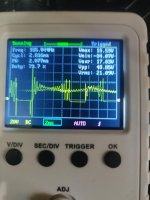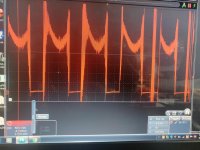It is a good friend's amp. I am determined to repair it for him if it is repairable. Whatever parts need to be changed, I am prepared to change them, order parts if necessary. If the board/transformer, etc is unable to allow proper operation then I will quit.
Without further guidance, I really don't know what else to do or am able to understand why what is happening, is happening. The only two things I can do with my limited understanding and experience, is:
Trace pin4 and pin5 of the driver board LM319 and see if they lead me somewhere.
Turn the pot on the driver board while testing in the car with music to see if the threshold changes.
Try a different set of outputs in the amp to see if it makes any difference.
I will try these three things and report back. Hopefully, one will lead to a successful outcome. Any recommendations or helpful information will be greatly appreciated.
I don't quit when something is difficult, I only quit when something is impossible...
Trace pin4 and pin5 of the driver board LM319 and see if they lead me somewhere.
Turn the pot on the driver board while testing in the car with music to see if the threshold changes.
Try a different set of outputs in the amp to see if it makes any difference.
I will try these three things and report back. Hopefully, one will lead to a successful outcome. Any recommendations or helpful information will be greatly appreciated.
I don't quit when something is difficult, I only quit when something is impossible...
From post 40, it doesn't sound like you're willing to take the risk of disabling the over-current protection.
I am willing to do whatever I am so instructed and guided to do. My hesitation was that in my past experiences, when too much current is drawn by a defective component, explosion or fire can soon follow. I know that you advise to individuals disabling protection, be prepared to remove power quickly in case something goes wrong.
Can you guide me further? I am ready to do as instructed.
Can you guide me further? I am ready to do as instructed.
The output of the 319 is open collector so it shouldn't do any harm to the drive circuit to connect pin 12 to pin 3.
This should stop the 319 from producing output and should disable the over-current protection. If there is a problem with the output inductors or anything else that the outputs drive, it could cause the outputs to fail and there goes the warning to be ready to remove power quickly.
Having all FETs clamped to the heatsink (or temporary heatsinks made of insulated aluminum bar stock) will help to protect them slightly.
A side note, virtually everything in this is from what you've told me about this amp. I have never had to do this with this model of amp (or any JL amp, actually).
This should stop the 319 from producing output and should disable the over-current protection. If there is a problem with the output inductors or anything else that the outputs drive, it could cause the outputs to fail and there goes the warning to be ready to remove power quickly.
Having all FETs clamped to the heatsink (or temporary heatsinks made of insulated aluminum bar stock) will help to protect them slightly.
A side note, virtually everything in this is from what you've told me about this amp. I have never had to do this with this model of amp (or any JL amp, actually).
After inserting the Pin12-3 jumper, do I test this on the bench with test tone, or in the car with music? Exactly what am I looking for when I test?
On the bench, my supply has current limiting bulbs which currently get a little bit bright, before the noise starts. Am I looking to see the bulbs get very bright and no noise? Am I just checking to see if I am able to exceed the cut off point noise free? I assume exceeding the limits untethered would cause failure of something so what do I look for, and when do I stop?
If testing in the vehicle using music, I am simply hoping that it would be able to deliver a forceful bass note. There is no current limiter in the vehicle, just fuses, so if something goes wrong there is no outboard protection. Once again, am I just hoping to be able to exceed the prior limitations?
On the bench, my supply has current limiting bulbs which currently get a little bit bright, before the noise starts. Am I looking to see the bulbs get very bright and no noise? Am I just checking to see if I am able to exceed the cut off point noise free? I assume exceeding the limits untethered would cause failure of something so what do I look for, and when do I stop?
If testing in the vehicle using music, I am simply hoping that it would be able to deliver a forceful bass note. There is no current limiter in the vehicle, just fuses, so if something goes wrong there is no outboard protection. Once again, am I just hoping to be able to exceed the prior limitations?
How were you testing when you posted the waveform of relatively low amplitude with the gaps in it?
If you mean post #28, that was on the bench with a 50hz tone, with the 2SC3200 transistor, that shuts down the 3525, removed. At the point when the noise occurred, and the amp would have shut down, it remained on and the noise just repeated itself.
With pin12-3 jumper in place, the amp has no output.
Tracked down the noise to the 2 vertical wrapped inductors. You had mentioned those previously. Do you suspect those of being bad. I have had to rewrap inductors in a JL 500/5 before, but those were visually overheated. The inductors in this amp have no overheating evidence and appear generally in good condition. I do not have anything that can measure inductance.
Tracked down the noise to the 2 vertical wrapped inductors. You had mentioned those previously. Do you suspect those of being bad. I have had to rewrap inductors in a JL 500/5 before, but those were visually overheated. The inductors in this amp have no overheating evidence and appear generally in good condition. I do not have anything that can measure inductance.
There is no rail to rail oscillation and no output when the pin12-pin3 jumper is in place. As soon as the jumper is removed, the amp works normal, except for the underlying cutting off issue.
I can also confirm, as you already suspected, the outputs have nothing to do with the issue. I swapped in the 8 IRF3710Z and tested. The amp made the noise at almost the same input voltage as the original outputs.
What can I try next? Would lifting pin12 off the pad be something to try?
I can also confirm, as you already suspected, the outputs have nothing to do with the issue. I swapped in the 8 IRF3710Z and tested. The amp made the noise at almost the same input voltage as the original outputs.
What can I try next? Would lifting pin12 off the pad be something to try?
That would be the next step. From the waveforms you posted, it looked like it needed to go low but that didn't work. Lifting pin 12 should allow the circuit to go high.
Lifted pin12 of the LM319 on the driver board, no change. Amp starts to buzz at roughly the same input voltage.
What next?
What next?
- Home
- General Interest
- Car Audio
- JL Audio E1800DM

